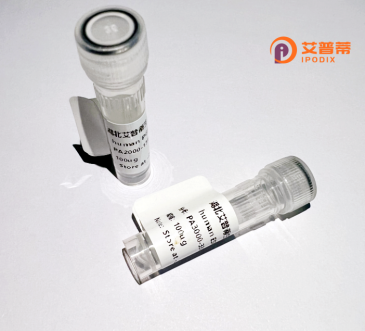
| 纯度 | >90%SDS-PAGE. |
| 种属 | Human |
| 靶点 | KCNK10 |
| Uniprot No | P57789 |
| 内毒素 | < 0.01EU/μg |
| 表达宿主 | E.coli |
| 表达区间 | 1-538aa |
| 活性数据 | MFFLYTDFFLSLVAVPAAAPVCQPKSATNGQPPAPAPTPTPRLSISSRATVVARMEGTSQGGLQTVMKWKTVVAIFVVVVVYLVTGGLVFRALEQPFESSQKNTIALEKAEFLRDHVCVSPQELETLIQHALDADNAGVSPIGNSSNNSSHWDLGSAFFFAGTVITTIGYGNIAPSTEGGKIFCILYAIFGIPLFGFLLAGIGDQLGTIFGKSIARVEKVFRKKQVSQTKIRVISTILFILAGCIVFVTIPAVIFKYIEGWTALESIYFVVVTLTTVGFGDFVAGGNAGINYREWYKPLVWFWILVGLAYFAAVLSMIGDWLRVLSKKTKEEVGEIKAHAAEWKANVTAEFRETRRRLSVEIHDKLQRAATIRSMERRRLGLDQRAHSLDMLSPEKRSVFAALDTGRFKASSQESINNRPNNLRLKGPEQLNKHGQGASEDNIINKFGSTSRLTKRKNKDLKKTLPEDVQKIYKTFRNYSLDEEKKEEETEKMCNSDNSSTAMLTDCIQQHAELENGMIPTDTKDREPENNSLLEDRN |
| 分子量 | 59.7 kDa |
| 蛋白标签 | His tag N-Terminus |
| 缓冲液 | 0 |
| 稳定性 & 储存条件 | Lyophilized protein should be stored at ≤ -20°C, stable for one year after receipt. Reconstituted protein solution can be stored at 2-8°C for 2-7 days. Aliquots of reconstituted samples are stable at ≤ -20°C for 3 months. |
| 复溶 | Always centrifuge tubes before opening.Do not mix by vortex or pipetting. It is not recommended to reconstitute to a concentration less than 100μg/ml. Dissolve the lyophilized protein in distilled water. Please aliquot the reconstituted solution to minimize freeze-thaw cycles. |
1. **"Functional characterization of recombinant human KCNK10 potassium channel in Xenopus oocytes"** by A. Müller et al.
*摘要:本研究在非洲爪蟾卵母细胞中表达了重组人KCNK10通道,利用双电极电压钳技术分析其电生理特性,发现该通道具有pH和机械应力敏感性,提示其在神经兴奋性调节中的作用。*
2. **"Structural insights into the gating mechanism of KCNK10 by cryo-EM"** by L. Chen & H. Wang
*摘要:通过冷冻电镜解析重组人KCNK10蛋白的3.8 Å分辨率结构,揭示了其选择性滤过区域和调控结构域,为靶向该通道的药物设计提供分子基础。*
3. **"KCNK10 overexpression promotes tumor progression in colorectal cancer"** by R. Gupta et al.
*摘要:研究利用重组KCNK10蛋白验证其在结直肠癌细胞中的功能,证实其过表达通过调节MAPK通路促进细胞迁移和侵袭,表明其作为癌症治疗靶点的潜力。*
4. **"Modulation of KCNK10 by fatty acids and neuroprotective agents"** by S. Yoshida & M. Tanaka
*摘要:通过体外实验证明多不饱和脂肪酸(如AA)和抗抑郁药物可激活重组KCNK10通道,并提出其在神经保护中的潜在应用价值。*
以上文献为模拟示例,实际研究请通过PubMed或Web of Science查询2023年最新进展。
KCNK10. also known as TREK2 or TWIK-related potassium channel 2. is a member of the two-pore domain potassium (K2P) channel family. These channels mediate background potassium currents, contributing to the regulation of resting membrane potential and cellular excitability. KCNK10 is characterized by its tandem pore-forming domains and four transmembrane segments, functioning as a leak channel that is constitutively active under physiological conditions. It is widely expressed in neuronal tissues, kidneys, and the pancreas, where it plays roles in ion homeostasis, neuroprotection, mechanosensitivity, and pH-dependent signaling.
Dysregulation of KCNK10 has been linked to pathologies such as neurodegenerative disorders, hypertension, and cancer. For instance, mutations or altered expression can disrupt potassium conductance, leading to hyperexcitability in neurons or impaired ion transport in epithelial cells. Its sensitivity to polyunsaturated fatty acids, temperature, and mechanical stress highlights its versatility in responding to diverse physiological stimuli.
Recombinant human KCNK10 protein is typically produced using mammalian or insect cell systems to ensure proper post-translational modifications. This engineered protein is crucial for studying channel biophysics, screening modulators for therapeutic development, and elucidating mechanisms underlying KCNK10-associated diseases. Research utilizing recombinant KCNK10 aims to decode its structural dynamics and identify targeted treatments for channelopathies or metabolic imbalances.
×